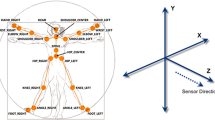Abstract
Human recognition by gaits is a new biometric method which considers both spatial and temporal features by tracking the gait at a distance. Most researches use image processing methods to analyze the moving object, while some use the model-based methods. Although some efforts have been devoted to the gait recognition, a high identification rate and a low computational cost still need to be achieved. This paper tends to investigate the gait recognition from the biomechanical point of view, which is lacking in the computer science and electronics communities. We present the method of people recognition by using both three-dimensional parameters of lower limb joints, namely, kinematic parameters (including joint angles and angular velocities) and kinetic parameters (joint forces). Dynamic data are acquired by tracking the maker positions using a motion capture system. 350 trials for 10 subjects are conducted, in which we use 20 trials for each one of these for training and the remaining 15 for testing. Additional 35 trials for another one subject not in the training set are conducted for testing the adventitious people. SOM neuron networks are employed for data classification. The importance of specific joints and variables is discussed in detail to investigate the major factors that cause the differences in human gait through a biomechanical approach. Experimental results show that gait is a reliable feature for individual identification since a high recognition rate can be achieved by choosing the proper joints or dynamic parameters of a gait. It also suggests that some joints and dynamic parameters dominate the differences in the walking style of people, which can be applied to both the biomedical and the computer vision fields.
Access this chapter
Tax calculation will be finalised at checkout
Purchases are for personal use only
Preview
Unable to display preview. Download preview PDF.
Similar content being viewed by others
References
Anil K. Jain, Fellow, IEEE, Arun Ross, Member, IEEE, and Salil Prabhakar, Member, IEEE (2004) An introduction to biometric recognition. IEEE transactions on circuits and systems for video technology. 14(1):4–20
Sarah V. Stevenage, Mark S. Nixon, Kate Vince, (1999) Visual Analysis of Gait as a Cue to Identity. Appl. Cognit. Psychol 13: 513–526
Mark S. Nixon, Member IEEE, John N. Carter, Member IEEE (2006) Automatic recognition by gait. Proceedings of the IEEE 94(11): 2013–2024
Fong-Chin Su, Wen-Lan Wu (2000) Design and testing of a genetic algorithm neural network in the assessment of gait patterns, Medical Engineering & Physics 22: 67–74
Wen-Lan Wu, Fong-Chin Su, (2000) Potential of the back propagation neutral network in the assessment of gait patterns in ankle arthrodesis. Clinical Biomechanics 15:143–145
Fong-Chin Su, Wen-Lan Wu, Yuh-Min Cheng, You-Li Chou (2001) Fuzzy clustering of gait patterns of patients after ankle arthrodesis based on kinematic parameters. Medical Engineering & Physics 23:83–90
Monika Kohle, Dicter Merkl, Josef Kastner (1997) Clinical gait analysis by neutral networks: issues and experiences. Tenth IEEE Symposium on Computer-Based Medical Systems pp 138–143
David K Wagg, Mark S Nixon (2004) On automated model-based extraction and analysis of gait. Proceedings of the Sixth IEEE International Conference on Automatic Face and Gesture Recognition’ 04 pp 11–16
Nikolaos V. Boulgouris, Dimitrios Hatzinakos, Konstantinos N. Plataniotis (2005) Gait recognition: A challenging signal processing technology for biometric identification. IEEE Signal Processing Magazine Nov, 78–90
Raquel Urtasun, Pascal Fua (2004) 3D Tracking for gait characterization and recognition. Proceedings of the Sixth IEEE International Conference on Automatic Face and Gesture Recognition’ 04 pp 138–143
Rong Zhang, Christian Vogler, Dimitris Metaxas (2004) Human gait recognition. Proceedings of the 2004 IEEE Computer Society Conference on Computer Vision and Pattern Recognition Workshops 2: 342–349
Author information
Authors and Affiliations
Editor information
Editors and Affiliations
Rights and permissions
Copyright information
© 2009 International Federation of Medical and Biological Engineering
About this paper
Cite this paper
Lin, YC., Yang, BS., Yang, YT. (2009). People Recognition by Kinematics and Kinetics of Gait. In: Lim, C.T., Goh, J.C.H. (eds) 13th International Conference on Biomedical Engineering. IFMBE Proceedings, vol 23. Springer, Berlin, Heidelberg. https://doi.org/10.1007/978-3-540-92841-6_497
Download citation
DOI: https://doi.org/10.1007/978-3-540-92841-6_497
Publisher Name: Springer, Berlin, Heidelberg
Print ISBN: 978-3-540-92840-9
Online ISBN: 978-3-540-92841-6
eBook Packages: EngineeringEngineering (R0)




